Strategic Thinking and Effective Change: Business Analysis Report
VerifiedAdded on 2020/02/14
|18
|4749
|49
Report
AI Summary
This report provides an executive summary on strategic thinking and effective change management within a business context. It begins by highlighting the importance of strategic planning and innovative thinking for organizational success in a competitive market. The report examines the challenges faced by a retail food company, including issues in communication, organizational culture, and employee performance, which have negatively impacted profitability and consumer satisfaction. The study utilizes secondary research to analyze change management theories, including Kurt Lewin's change management model and Maslow's hierarchy of needs, to propose strategies for addressing these challenges. The report recommends implementing a change management strategy based on Kurt Lewin's model to foster positive growth and minimize resistance to change, while also considering the limitations of the research due to time and data constraints. Key findings emphasize the need to understand employee needs and effectively communicate changes to enhance organizational performance and achieve the company's objectives.
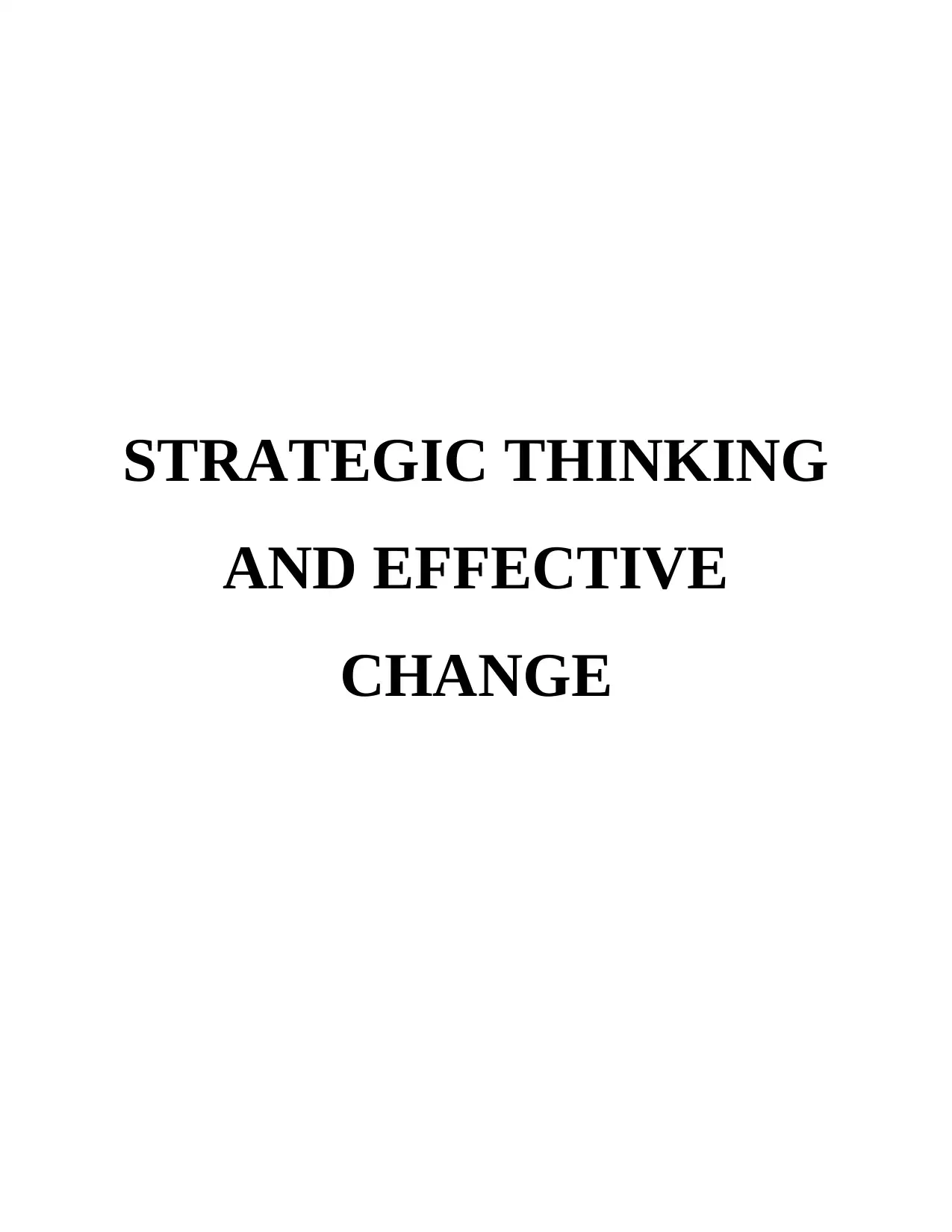
STRATEGIC THINKING
AND EFFECTIVE
CHANGE
AND EFFECTIVE
CHANGE
Paraphrase This Document
Need a fresh take? Get an instant paraphrase of this document with our AI Paraphraser
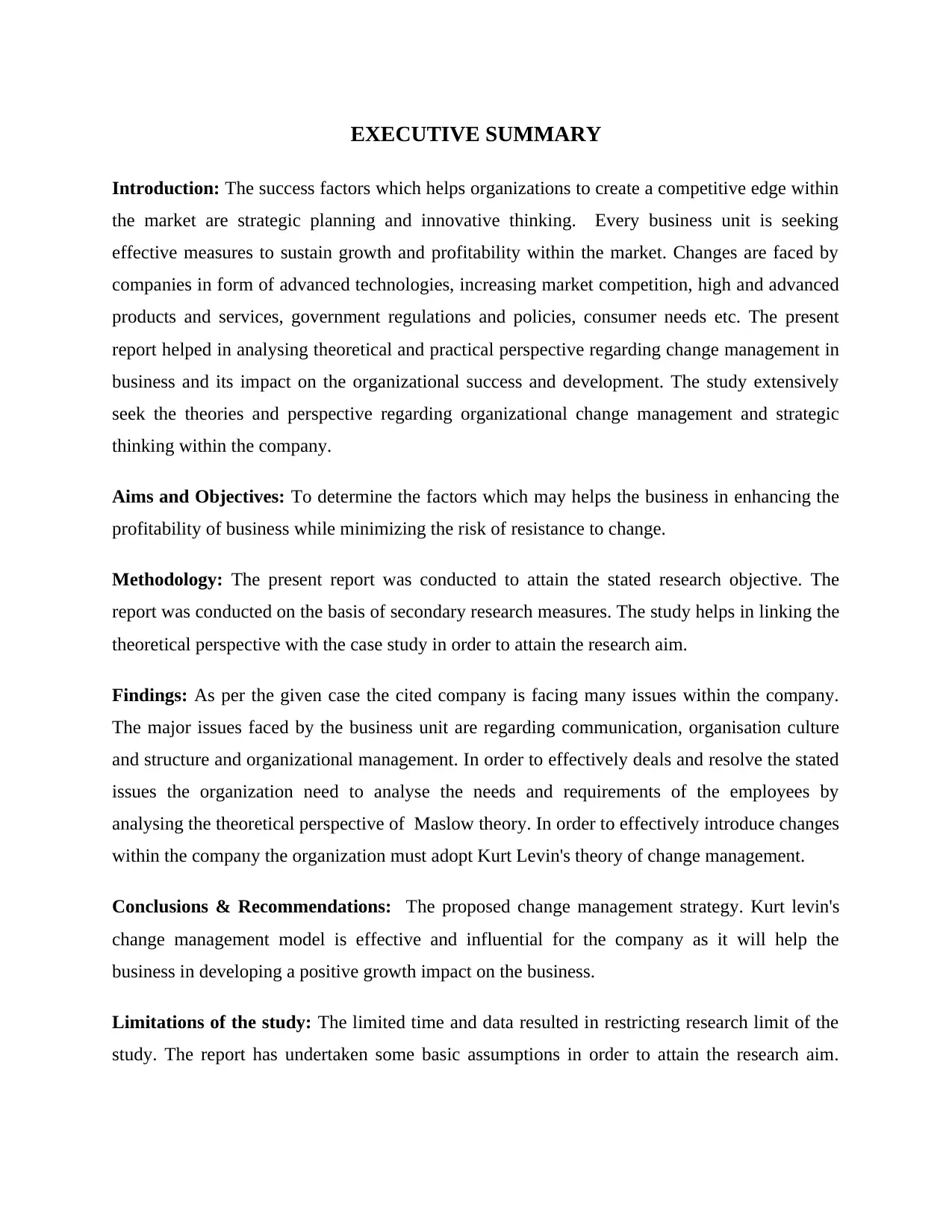
EXECUTIVE SUMMARY
Introduction: The success factors which helps organizations to create a competitive edge within
the market are strategic planning and innovative thinking. Every business unit is seeking
effective measures to sustain growth and profitability within the market. Changes are faced by
companies in form of advanced technologies, increasing market competition, high and advanced
products and services, government regulations and policies, consumer needs etc. The present
report helped in analysing theoretical and practical perspective regarding change management in
business and its impact on the organizational success and development. The study extensively
seek the theories and perspective regarding organizational change management and strategic
thinking within the company.
Aims and Objectives: To determine the factors which may helps the business in enhancing the
profitability of business while minimizing the risk of resistance to change.
Methodology: The present report was conducted to attain the stated research objective. The
report was conducted on the basis of secondary research measures. The study helps in linking the
theoretical perspective with the case study in order to attain the research aim.
Findings: As per the given case the cited company is facing many issues within the company.
The major issues faced by the business unit are regarding communication, organisation culture
and structure and organizational management. In order to effectively deals and resolve the stated
issues the organization need to analyse the needs and requirements of the employees by
analysing the theoretical perspective of Maslow theory. In order to effectively introduce changes
within the company the organization must adopt Kurt Levin's theory of change management.
Conclusions & Recommendations: The proposed change management strategy. Kurt levin's
change management model is effective and influential for the company as it will help the
business in developing a positive growth impact on the business.
Limitations of the study: The limited time and data resulted in restricting research limit of the
study. The report has undertaken some basic assumptions in order to attain the research aim.
Introduction: The success factors which helps organizations to create a competitive edge within
the market are strategic planning and innovative thinking. Every business unit is seeking
effective measures to sustain growth and profitability within the market. Changes are faced by
companies in form of advanced technologies, increasing market competition, high and advanced
products and services, government regulations and policies, consumer needs etc. The present
report helped in analysing theoretical and practical perspective regarding change management in
business and its impact on the organizational success and development. The study extensively
seek the theories and perspective regarding organizational change management and strategic
thinking within the company.
Aims and Objectives: To determine the factors which may helps the business in enhancing the
profitability of business while minimizing the risk of resistance to change.
Methodology: The present report was conducted to attain the stated research objective. The
report was conducted on the basis of secondary research measures. The study helps in linking the
theoretical perspective with the case study in order to attain the research aim.
Findings: As per the given case the cited company is facing many issues within the company.
The major issues faced by the business unit are regarding communication, organisation culture
and structure and organizational management. In order to effectively deals and resolve the stated
issues the organization need to analyse the needs and requirements of the employees by
analysing the theoretical perspective of Maslow theory. In order to effectively introduce changes
within the company the organization must adopt Kurt Levin's theory of change management.
Conclusions & Recommendations: The proposed change management strategy. Kurt levin's
change management model is effective and influential for the company as it will help the
business in developing a positive growth impact on the business.
Limitations of the study: The limited time and data resulted in restricting research limit of the
study. The report has undertaken some basic assumptions in order to attain the research aim.
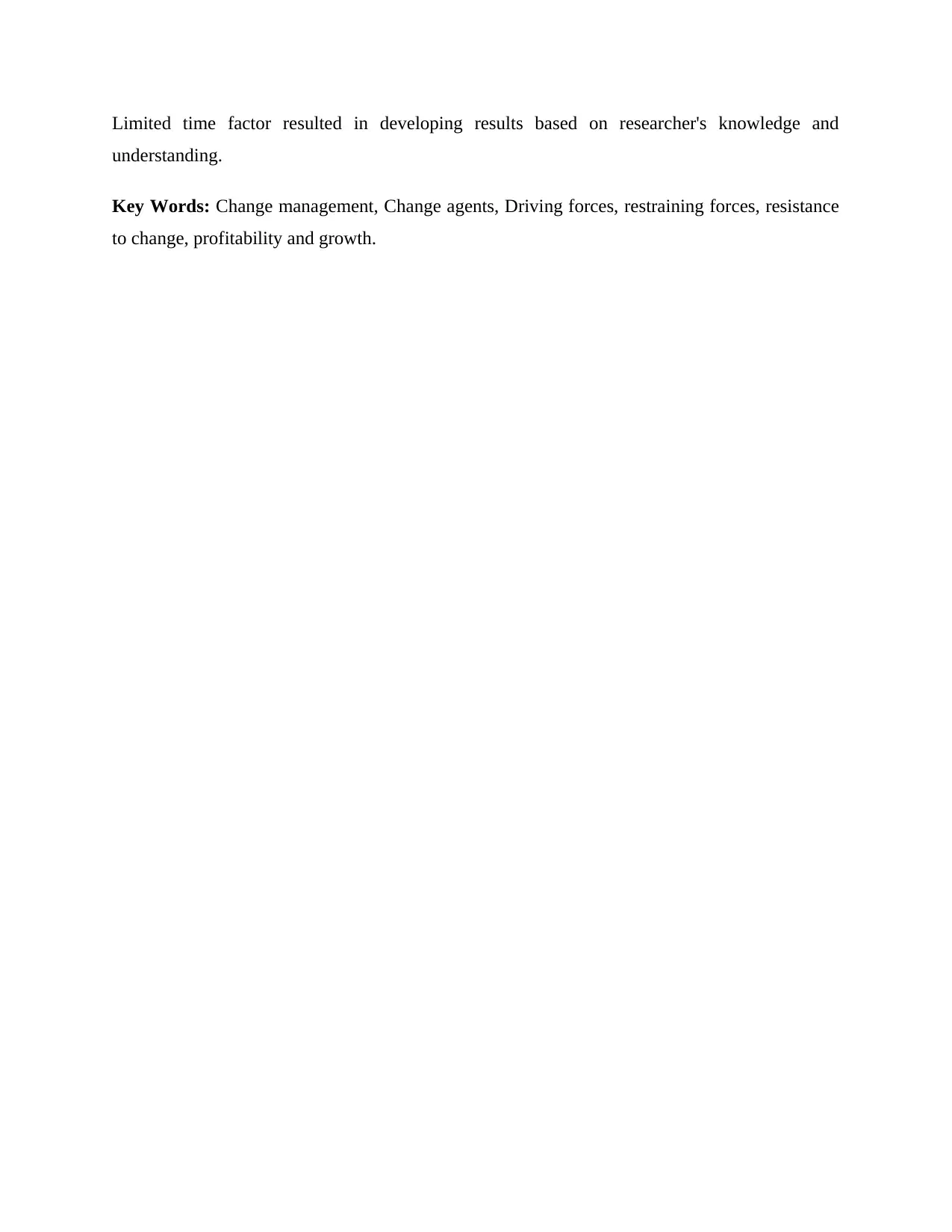
Limited time factor resulted in developing results based on researcher's knowledge and
understanding.
Key Words: Change management, Change agents, Driving forces, restraining forces, resistance
to change, profitability and growth.
understanding.
Key Words: Change management, Change agents, Driving forces, restraining forces, resistance
to change, profitability and growth.
⊘ This is a preview!⊘
Do you want full access?
Subscribe today to unlock all pages.

Trusted by 1+ million students worldwide
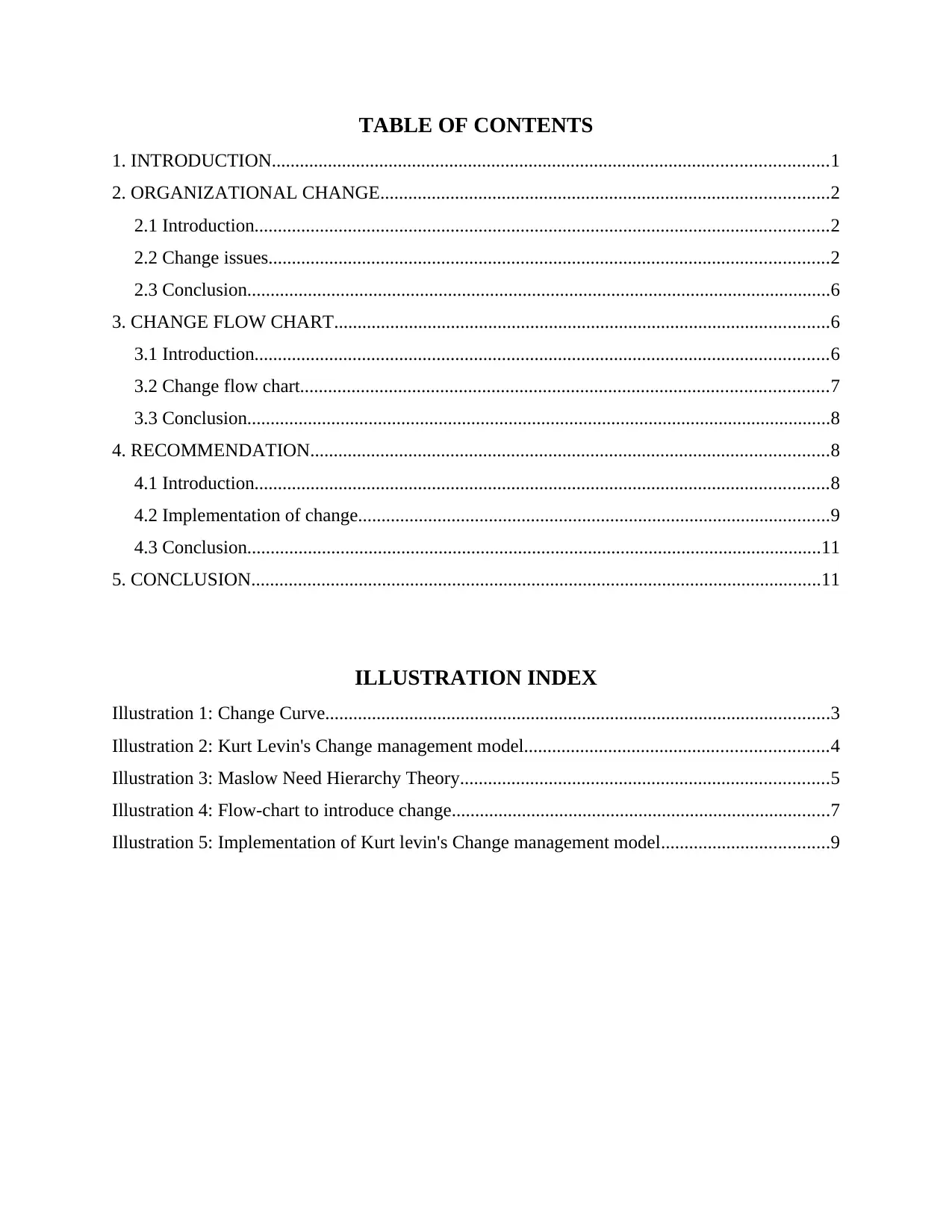
TABLE OF CONTENTS
1. INTRODUCTION.......................................................................................................................1
2. ORGANIZATIONAL CHANGE................................................................................................2
2.1 Introduction...........................................................................................................................2
2.2 Change issues........................................................................................................................2
2.3 Conclusion.............................................................................................................................6
3. CHANGE FLOW CHART..........................................................................................................6
3.1 Introduction...........................................................................................................................6
3.2 Change flow chart.................................................................................................................7
3.3 Conclusion.............................................................................................................................8
4. RECOMMENDATION...............................................................................................................8
4.1 Introduction...........................................................................................................................8
4.2 Implementation of change.....................................................................................................9
4.3 Conclusion...........................................................................................................................11
5. CONCLUSION..........................................................................................................................11
ILLUSTRATION INDEX
Illustration 1: Change Curve............................................................................................................3
Illustration 2: Kurt Levin's Change management model.................................................................4
Illustration 3: Maslow Need Hierarchy Theory...............................................................................5
Illustration 4: Flow-chart to introduce change.................................................................................7
Illustration 5: Implementation of Kurt levin's Change management model....................................9
1. INTRODUCTION.......................................................................................................................1
2. ORGANIZATIONAL CHANGE................................................................................................2
2.1 Introduction...........................................................................................................................2
2.2 Change issues........................................................................................................................2
2.3 Conclusion.............................................................................................................................6
3. CHANGE FLOW CHART..........................................................................................................6
3.1 Introduction...........................................................................................................................6
3.2 Change flow chart.................................................................................................................7
3.3 Conclusion.............................................................................................................................8
4. RECOMMENDATION...............................................................................................................8
4.1 Introduction...........................................................................................................................8
4.2 Implementation of change.....................................................................................................9
4.3 Conclusion...........................................................................................................................11
5. CONCLUSION..........................................................................................................................11
ILLUSTRATION INDEX
Illustration 1: Change Curve............................................................................................................3
Illustration 2: Kurt Levin's Change management model.................................................................4
Illustration 3: Maslow Need Hierarchy Theory...............................................................................5
Illustration 4: Flow-chart to introduce change.................................................................................7
Illustration 5: Implementation of Kurt levin's Change management model....................................9
Paraphrase This Document
Need a fresh take? Get an instant paraphrase of this document with our AI Paraphraser
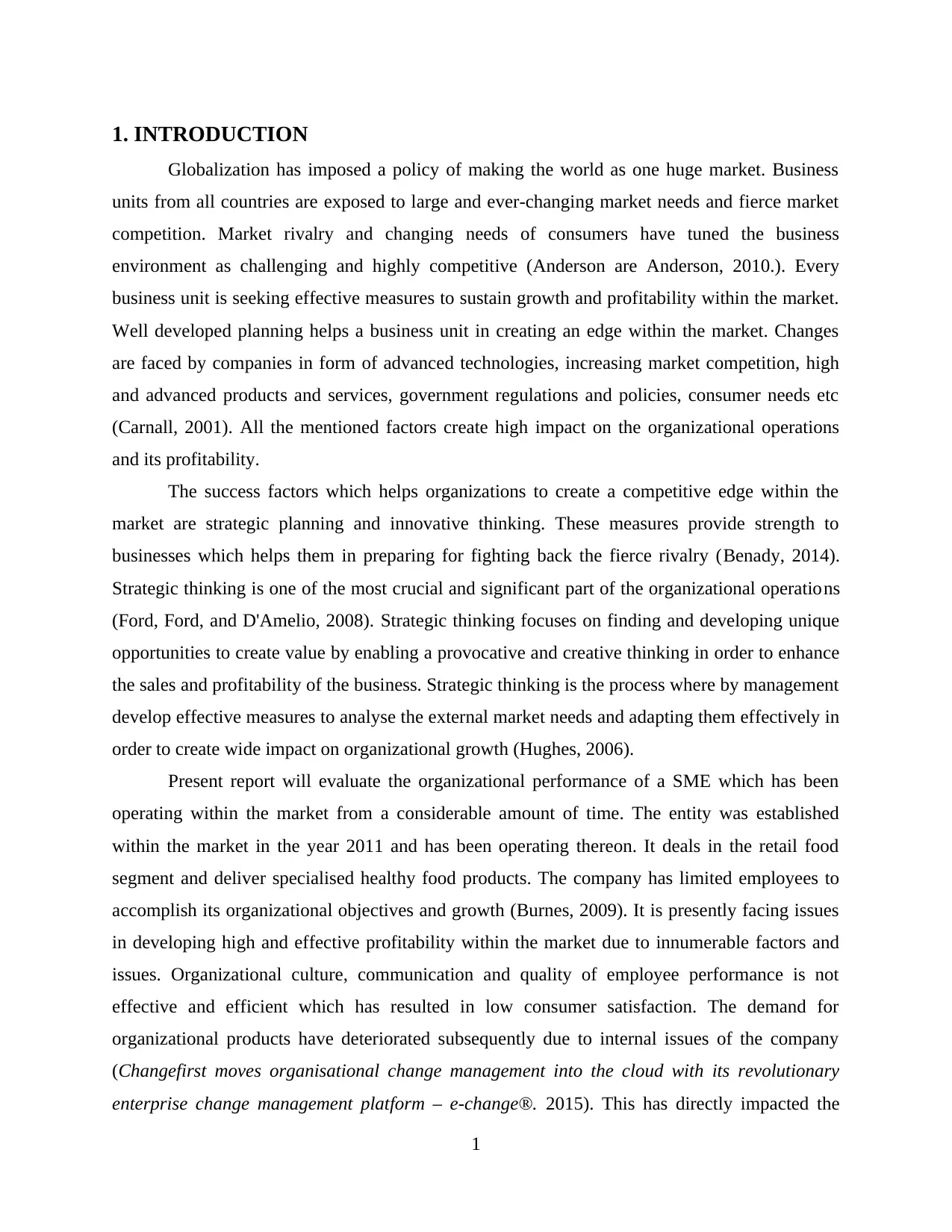
1. INTRODUCTION
Globalization has imposed a policy of making the world as one huge market. Business
units from all countries are exposed to large and ever-changing market needs and fierce market
competition. Market rivalry and changing needs of consumers have tuned the business
environment as challenging and highly competitive (Anderson are Anderson, 2010.). Every
business unit is seeking effective measures to sustain growth and profitability within the market.
Well developed planning helps a business unit in creating an edge within the market. Changes
are faced by companies in form of advanced technologies, increasing market competition, high
and advanced products and services, government regulations and policies, consumer needs etc
(Carnall, 2001). All the mentioned factors create high impact on the organizational operations
and its profitability.
The success factors which helps organizations to create a competitive edge within the
market are strategic planning and innovative thinking. These measures provide strength to
businesses which helps them in preparing for fighting back the fierce rivalry (Benady, 2014).
Strategic thinking is one of the most crucial and significant part of the organizational operations
(Ford, Ford, and D'Amelio, 2008). Strategic thinking focuses on finding and developing unique
opportunities to create value by enabling a provocative and creative thinking in order to enhance
the sales and profitability of the business. Strategic thinking is the process where by management
develop effective measures to analyse the external market needs and adapting them effectively in
order to create wide impact on organizational growth (Hughes, 2006).
Present report will evaluate the organizational performance of a SME which has been
operating within the market from a considerable amount of time. The entity was established
within the market in the year 2011 and has been operating thereon. It deals in the retail food
segment and deliver specialised healthy food products. The company has limited employees to
accomplish its organizational objectives and growth (Burnes, 2009). It is presently facing issues
in developing high and effective profitability within the market due to innumerable factors and
issues. Organizational culture, communication and quality of employee performance is not
effective and efficient which has resulted in low consumer satisfaction. The demand for
organizational products have deteriorated subsequently due to internal issues of the company
(Changefirst moves organisational change management into the cloud with its revolutionary
enterprise change management platform – e-change®. 2015). This has directly impacted the
1
Globalization has imposed a policy of making the world as one huge market. Business
units from all countries are exposed to large and ever-changing market needs and fierce market
competition. Market rivalry and changing needs of consumers have tuned the business
environment as challenging and highly competitive (Anderson are Anderson, 2010.). Every
business unit is seeking effective measures to sustain growth and profitability within the market.
Well developed planning helps a business unit in creating an edge within the market. Changes
are faced by companies in form of advanced technologies, increasing market competition, high
and advanced products and services, government regulations and policies, consumer needs etc
(Carnall, 2001). All the mentioned factors create high impact on the organizational operations
and its profitability.
The success factors which helps organizations to create a competitive edge within the
market are strategic planning and innovative thinking. These measures provide strength to
businesses which helps them in preparing for fighting back the fierce rivalry (Benady, 2014).
Strategic thinking is one of the most crucial and significant part of the organizational operations
(Ford, Ford, and D'Amelio, 2008). Strategic thinking focuses on finding and developing unique
opportunities to create value by enabling a provocative and creative thinking in order to enhance
the sales and profitability of the business. Strategic thinking is the process where by management
develop effective measures to analyse the external market needs and adapting them effectively in
order to create wide impact on organizational growth (Hughes, 2006).
Present report will evaluate the organizational performance of a SME which has been
operating within the market from a considerable amount of time. The entity was established
within the market in the year 2011 and has been operating thereon. It deals in the retail food
segment and deliver specialised healthy food products. The company has limited employees to
accomplish its organizational objectives and growth (Burnes, 2009). It is presently facing issues
in developing high and effective profitability within the market due to innumerable factors and
issues. Organizational culture, communication and quality of employee performance is not
effective and efficient which has resulted in low consumer satisfaction. The demand for
organizational products have deteriorated subsequently due to internal issues of the company
(Changefirst moves organisational change management into the cloud with its revolutionary
enterprise change management platform – e-change®. 2015). This has directly impacted the
1
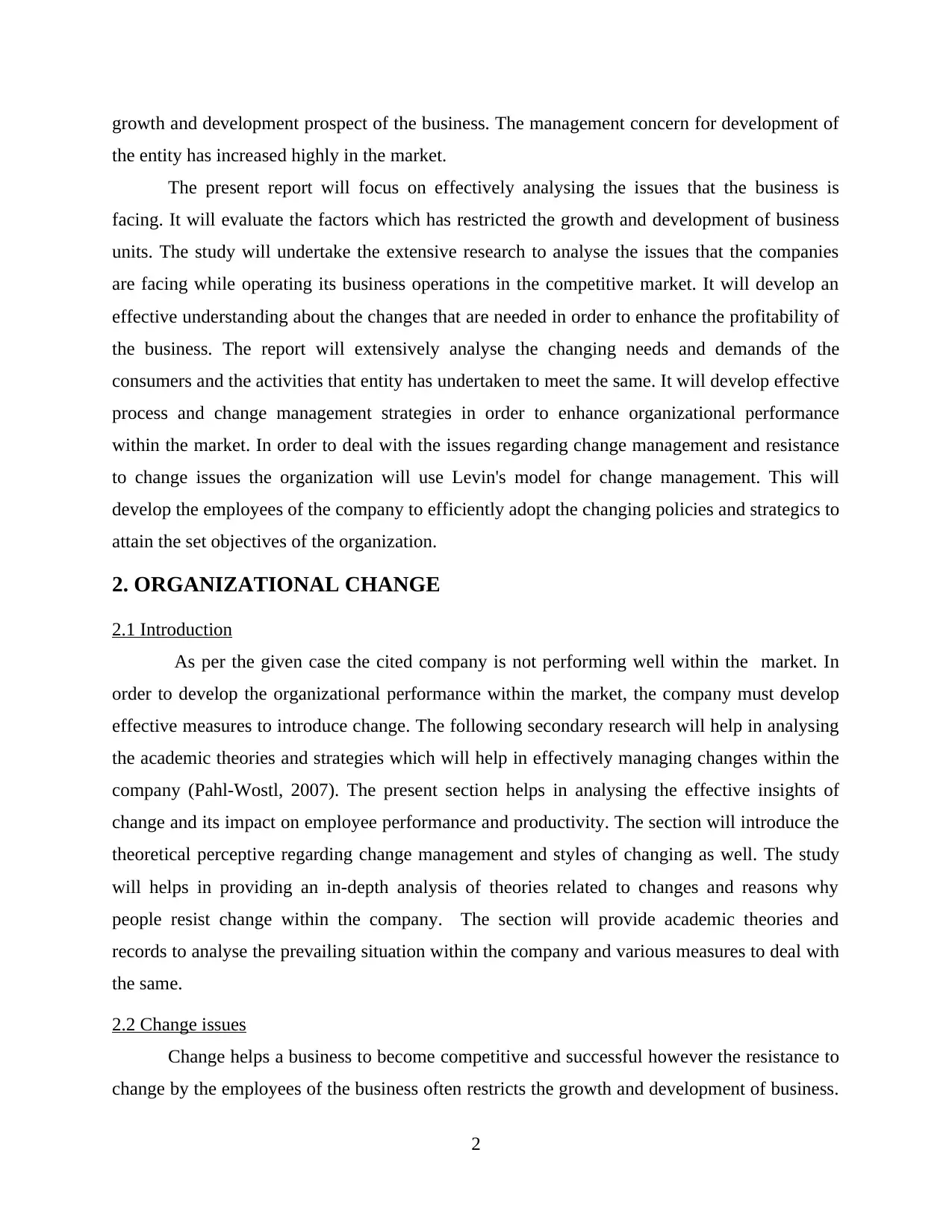
growth and development prospect of the business. The management concern for development of
the entity has increased highly in the market.
The present report will focus on effectively analysing the issues that the business is
facing. It will evaluate the factors which has restricted the growth and development of business
units. The study will undertake the extensive research to analyse the issues that the companies
are facing while operating its business operations in the competitive market. It will develop an
effective understanding about the changes that are needed in order to enhance the profitability of
the business. The report will extensively analyse the changing needs and demands of the
consumers and the activities that entity has undertaken to meet the same. It will develop effective
process and change management strategies in order to enhance organizational performance
within the market. In order to deal with the issues regarding change management and resistance
to change issues the organization will use Levin's model for change management. This will
develop the employees of the company to efficiently adopt the changing policies and strategics to
attain the set objectives of the organization.
2. ORGANIZATIONAL CHANGE
2.1 Introduction
As per the given case the cited company is not performing well within the market. In
order to develop the organizational performance within the market, the company must develop
effective measures to introduce change. The following secondary research will help in analysing
the academic theories and strategies which will help in effectively managing changes within the
company (Pahl-Wostl, 2007). The present section helps in analysing the effective insights of
change and its impact on employee performance and productivity. The section will introduce the
theoretical perceptive regarding change management and styles of changing as well. The study
will helps in providing an in-depth analysis of theories related to changes and reasons why
people resist change within the company. The section will provide academic theories and
records to analyse the prevailing situation within the company and various measures to deal with
the same.
2.2 Change issues
Change helps a business to become competitive and successful however the resistance to
change by the employees of the business often restricts the growth and development of business.
2
the entity has increased highly in the market.
The present report will focus on effectively analysing the issues that the business is
facing. It will evaluate the factors which has restricted the growth and development of business
units. The study will undertake the extensive research to analyse the issues that the companies
are facing while operating its business operations in the competitive market. It will develop an
effective understanding about the changes that are needed in order to enhance the profitability of
the business. The report will extensively analyse the changing needs and demands of the
consumers and the activities that entity has undertaken to meet the same. It will develop effective
process and change management strategies in order to enhance organizational performance
within the market. In order to deal with the issues regarding change management and resistance
to change issues the organization will use Levin's model for change management. This will
develop the employees of the company to efficiently adopt the changing policies and strategics to
attain the set objectives of the organization.
2. ORGANIZATIONAL CHANGE
2.1 Introduction
As per the given case the cited company is not performing well within the market. In
order to develop the organizational performance within the market, the company must develop
effective measures to introduce change. The following secondary research will help in analysing
the academic theories and strategies which will help in effectively managing changes within the
company (Pahl-Wostl, 2007). The present section helps in analysing the effective insights of
change and its impact on employee performance and productivity. The section will introduce the
theoretical perceptive regarding change management and styles of changing as well. The study
will helps in providing an in-depth analysis of theories related to changes and reasons why
people resist change within the company. The section will provide academic theories and
records to analyse the prevailing situation within the company and various measures to deal with
the same.
2.2 Change issues
Change helps a business to become competitive and successful however the resistance to
change by the employees of the business often restricts the growth and development of business.
2
⊘ This is a preview!⊘
Do you want full access?
Subscribe today to unlock all pages.

Trusted by 1+ million students worldwide

Change is inevitable and is crucial in order to enhance the organizational growth and
productivity (Kotter, 2008). The driving and restraining factors are significant to be known and
understood in order to enhance the organizational objectives.
Change curve
Change is an ongoing process which is unavoidable and inevitable as well. According to
AUTHOR change curve helps in analysing and understanding the impact of change on individual
or groups within the company. The stated model helps the the management in effectively
understanding and involving effective elements of change.
The above diagram helps in analysing the impact of change on the employees of the
company and how they react with the changing patterns and routines. Elizabeth Kübler-Ross
(1969) contributed the famous theory of change curve which explains how human being consider
the changing situation and how they deal with the same. As per the curve the employee reaction
to the changes are stated in the stages of: Shock: This is the stage where the employees are introduced with the changing situations.
This stage reflects the initial shock after hearing the announcement of upcoming change. Denial: This stage as per the curve arise after a little time of the news. This stage reflects
the belief of a person that change is not going to affect their work or schedule (Brown
and Harvey, 2011).
3
Illustration 1: Change Curve
(Source: The Change Curve, 2011)
productivity (Kotter, 2008). The driving and restraining factors are significant to be known and
understood in order to enhance the organizational objectives.
Change curve
Change is an ongoing process which is unavoidable and inevitable as well. According to
AUTHOR change curve helps in analysing and understanding the impact of change on individual
or groups within the company. The stated model helps the the management in effectively
understanding and involving effective elements of change.
The above diagram helps in analysing the impact of change on the employees of the
company and how they react with the changing patterns and routines. Elizabeth Kübler-Ross
(1969) contributed the famous theory of change curve which explains how human being consider
the changing situation and how they deal with the same. As per the curve the employee reaction
to the changes are stated in the stages of: Shock: This is the stage where the employees are introduced with the changing situations.
This stage reflects the initial shock after hearing the announcement of upcoming change. Denial: This stage as per the curve arise after a little time of the news. This stage reflects
the belief of a person that change is not going to affect their work or schedule (Brown
and Harvey, 2011).
3
Illustration 1: Change Curve
(Source: The Change Curve, 2011)
Paraphrase This Document
Need a fresh take? Get an instant paraphrase of this document with our AI Paraphraser
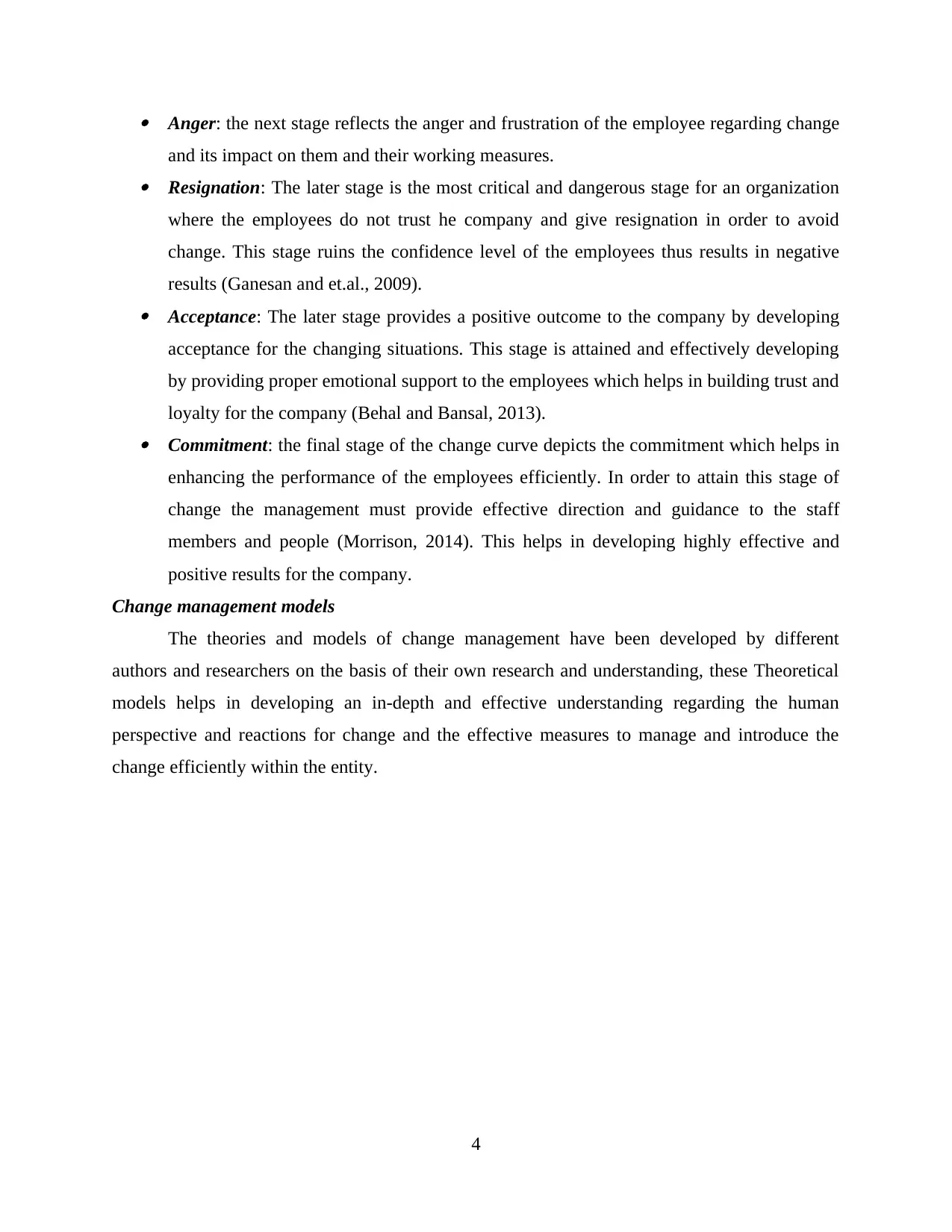
Anger: the next stage reflects the anger and frustration of the employee regarding change
and its impact on them and their working measures. Resignation: The later stage is the most critical and dangerous stage for an organization
where the employees do not trust he company and give resignation in order to avoid
change. This stage ruins the confidence level of the employees thus results in negative
results (Ganesan and et.al., 2009). Acceptance: The later stage provides a positive outcome to the company by developing
acceptance for the changing situations. This stage is attained and effectively developing
by providing proper emotional support to the employees which helps in building trust and
loyalty for the company (Behal and Bansal, 2013). Commitment: the final stage of the change curve depicts the commitment which helps in
enhancing the performance of the employees efficiently. In order to attain this stage of
change the management must provide effective direction and guidance to the staff
members and people (Morrison, 2014). This helps in developing highly effective and
positive results for the company.
Change management models
The theories and models of change management have been developed by different
authors and researchers on the basis of their own research and understanding, these Theoretical
models helps in developing an in-depth and effective understanding regarding the human
perspective and reactions for change and the effective measures to manage and introduce the
change efficiently within the entity.
4
and its impact on them and their working measures. Resignation: The later stage is the most critical and dangerous stage for an organization
where the employees do not trust he company and give resignation in order to avoid
change. This stage ruins the confidence level of the employees thus results in negative
results (Ganesan and et.al., 2009). Acceptance: The later stage provides a positive outcome to the company by developing
acceptance for the changing situations. This stage is attained and effectively developing
by providing proper emotional support to the employees which helps in building trust and
loyalty for the company (Behal and Bansal, 2013). Commitment: the final stage of the change curve depicts the commitment which helps in
enhancing the performance of the employees efficiently. In order to attain this stage of
change the management must provide effective direction and guidance to the staff
members and people (Morrison, 2014). This helps in developing highly effective and
positive results for the company.
Change management models
The theories and models of change management have been developed by different
authors and researchers on the basis of their own research and understanding, these Theoretical
models helps in developing an in-depth and effective understanding regarding the human
perspective and reactions for change and the effective measures to manage and introduce the
change efficiently within the entity.
4
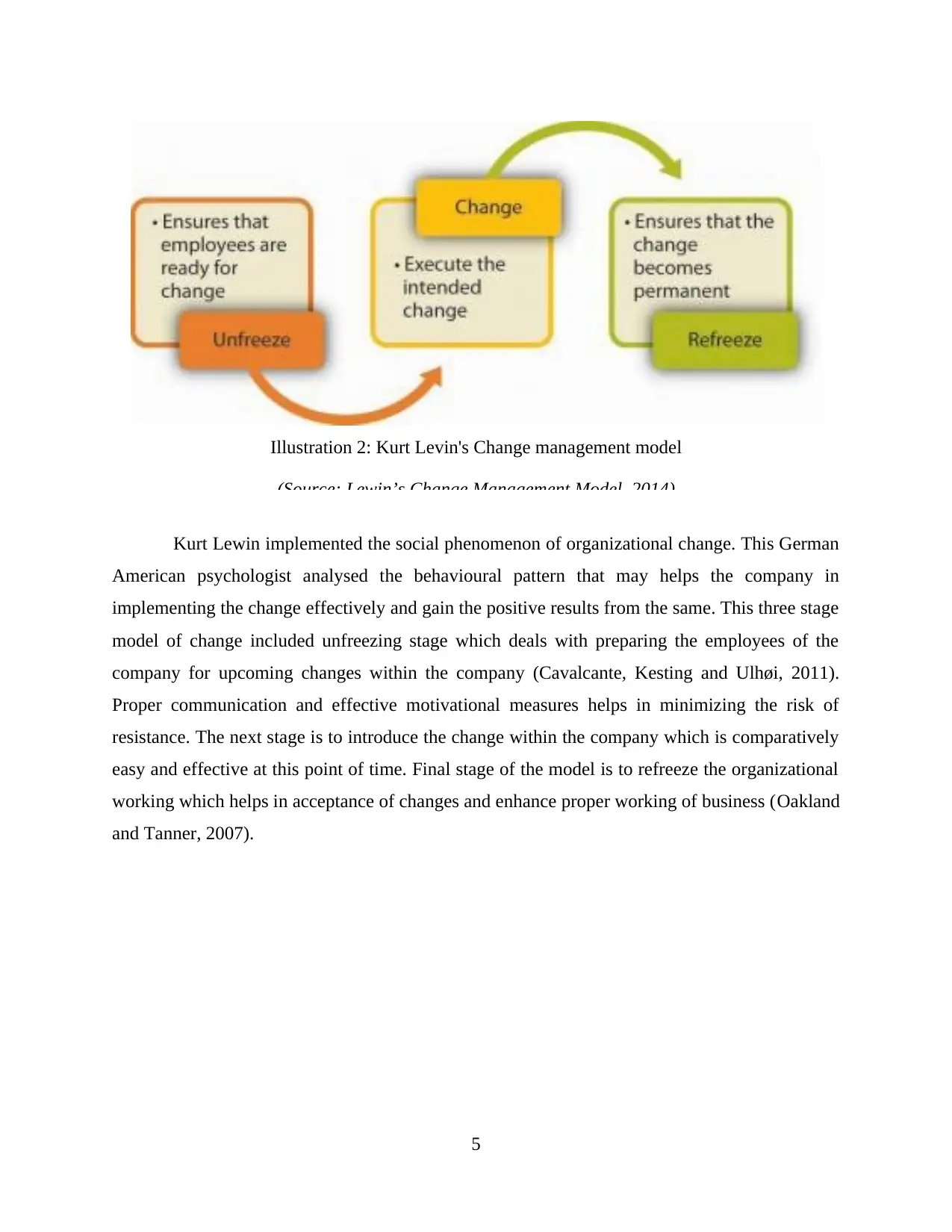
Kurt Lewin implemented the social phenomenon of organizational change. This German
American psychologist analysed the behavioural pattern that may helps the company in
implementing the change effectively and gain the positive results from the same. This three stage
model of change included unfreezing stage which deals with preparing the employees of the
company for upcoming changes within the company (Cavalcante, Kesting and Ulhøi, 2011).
Proper communication and effective motivational measures helps in minimizing the risk of
resistance. The next stage is to introduce the change within the company which is comparatively
easy and effective at this point of time. Final stage of the model is to refreeze the organizational
working which helps in acceptance of changes and enhance proper working of business (Oakland
and Tanner, 2007).
5
Illustration 2: Kurt Levin's Change management model
(Source: Lewin’s Change Management Model, 2014)
American psychologist analysed the behavioural pattern that may helps the company in
implementing the change effectively and gain the positive results from the same. This three stage
model of change included unfreezing stage which deals with preparing the employees of the
company for upcoming changes within the company (Cavalcante, Kesting and Ulhøi, 2011).
Proper communication and effective motivational measures helps in minimizing the risk of
resistance. The next stage is to introduce the change within the company which is comparatively
easy and effective at this point of time. Final stage of the model is to refreeze the organizational
working which helps in acceptance of changes and enhance proper working of business (Oakland
and Tanner, 2007).
5
Illustration 2: Kurt Levin's Change management model
(Source: Lewin’s Change Management Model, 2014)
⊘ This is a preview!⊘
Do you want full access?
Subscribe today to unlock all pages.

Trusted by 1+ million students worldwide
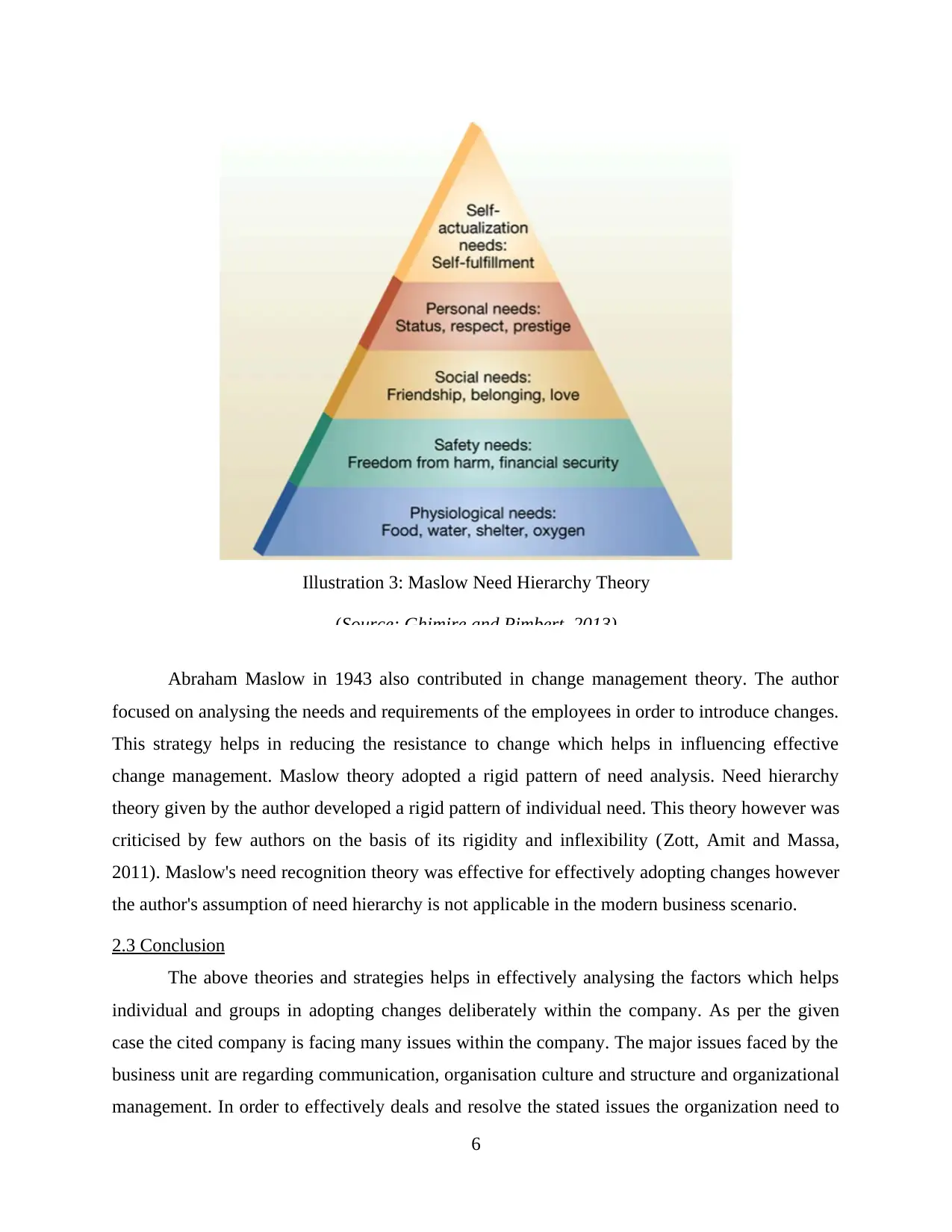
Abraham Maslow in 1943 also contributed in change management theory. The author
focused on analysing the needs and requirements of the employees in order to introduce changes.
This strategy helps in reducing the resistance to change which helps in influencing effective
change management. Maslow theory adopted a rigid pattern of need analysis. Need hierarchy
theory given by the author developed a rigid pattern of individual need. This theory however was
criticised by few authors on the basis of its rigidity and inflexibility (Zott, Amit and Massa,
2011). Maslow's need recognition theory was effective for effectively adopting changes however
the author's assumption of need hierarchy is not applicable in the modern business scenario.
2.3 Conclusion
The above theories and strategies helps in effectively analysing the factors which helps
individual and groups in adopting changes deliberately within the company. As per the given
case the cited company is facing many issues within the company. The major issues faced by the
business unit are regarding communication, organisation culture and structure and organizational
management. In order to effectively deals and resolve the stated issues the organization need to
6
Illustration 3: Maslow Need Hierarchy Theory
(Source: Ghimire and Pimbert, 2013)
focused on analysing the needs and requirements of the employees in order to introduce changes.
This strategy helps in reducing the resistance to change which helps in influencing effective
change management. Maslow theory adopted a rigid pattern of need analysis. Need hierarchy
theory given by the author developed a rigid pattern of individual need. This theory however was
criticised by few authors on the basis of its rigidity and inflexibility (Zott, Amit and Massa,
2011). Maslow's need recognition theory was effective for effectively adopting changes however
the author's assumption of need hierarchy is not applicable in the modern business scenario.
2.3 Conclusion
The above theories and strategies helps in effectively analysing the factors which helps
individual and groups in adopting changes deliberately within the company. As per the given
case the cited company is facing many issues within the company. The major issues faced by the
business unit are regarding communication, organisation culture and structure and organizational
management. In order to effectively deals and resolve the stated issues the organization need to
6
Illustration 3: Maslow Need Hierarchy Theory
(Source: Ghimire and Pimbert, 2013)
Paraphrase This Document
Need a fresh take? Get an instant paraphrase of this document with our AI Paraphraser

analyse the needs and requirements of the employees by analysing the theoretical perspective of
Maslow theory. This will help in understanding the factors which can help the company in
effectively analysing and understanding the motivating factors for the employees. In order to
effectively introduce changes within the company the organization must adopt Kurt Levin's
theory of change management.
3. CHANGE FLOW CHART
3.1 Introduction
The given case about the cited SME reflects that the organization is not effectively
performing in the present competitive world. The change flow chart will helps the company in
effectively analysing the needs of the company in order to introduce the required changes. The
stated company is unable to deliver effective services to the consumers due low ineffective
organizational culture and chaos regarding structure of the company (Leban and Stone, 2007).
Moreover weak communication repeatedly creates an issue of duplication of roles and
responsibilities and developing wide chaos and confusion. The stated change flowchart will help
in overcoming the stated issues and develop favourable outcomes for the organizational growth.
The adaptation of of Levin's model of change management will helps the company in reducing
the resistance to change as well.
3.2 Change flow chart
7
Maslow theory. This will help in understanding the factors which can help the company in
effectively analysing and understanding the motivating factors for the employees. In order to
effectively introduce changes within the company the organization must adopt Kurt Levin's
theory of change management.
3. CHANGE FLOW CHART
3.1 Introduction
The given case about the cited SME reflects that the organization is not effectively
performing in the present competitive world. The change flow chart will helps the company in
effectively analysing the needs of the company in order to introduce the required changes. The
stated company is unable to deliver effective services to the consumers due low ineffective
organizational culture and chaos regarding structure of the company (Leban and Stone, 2007).
Moreover weak communication repeatedly creates an issue of duplication of roles and
responsibilities and developing wide chaos and confusion. The stated change flowchart will help
in overcoming the stated issues and develop favourable outcomes for the organizational growth.
The adaptation of of Levin's model of change management will helps the company in reducing
the resistance to change as well.
3.2 Change flow chart
7
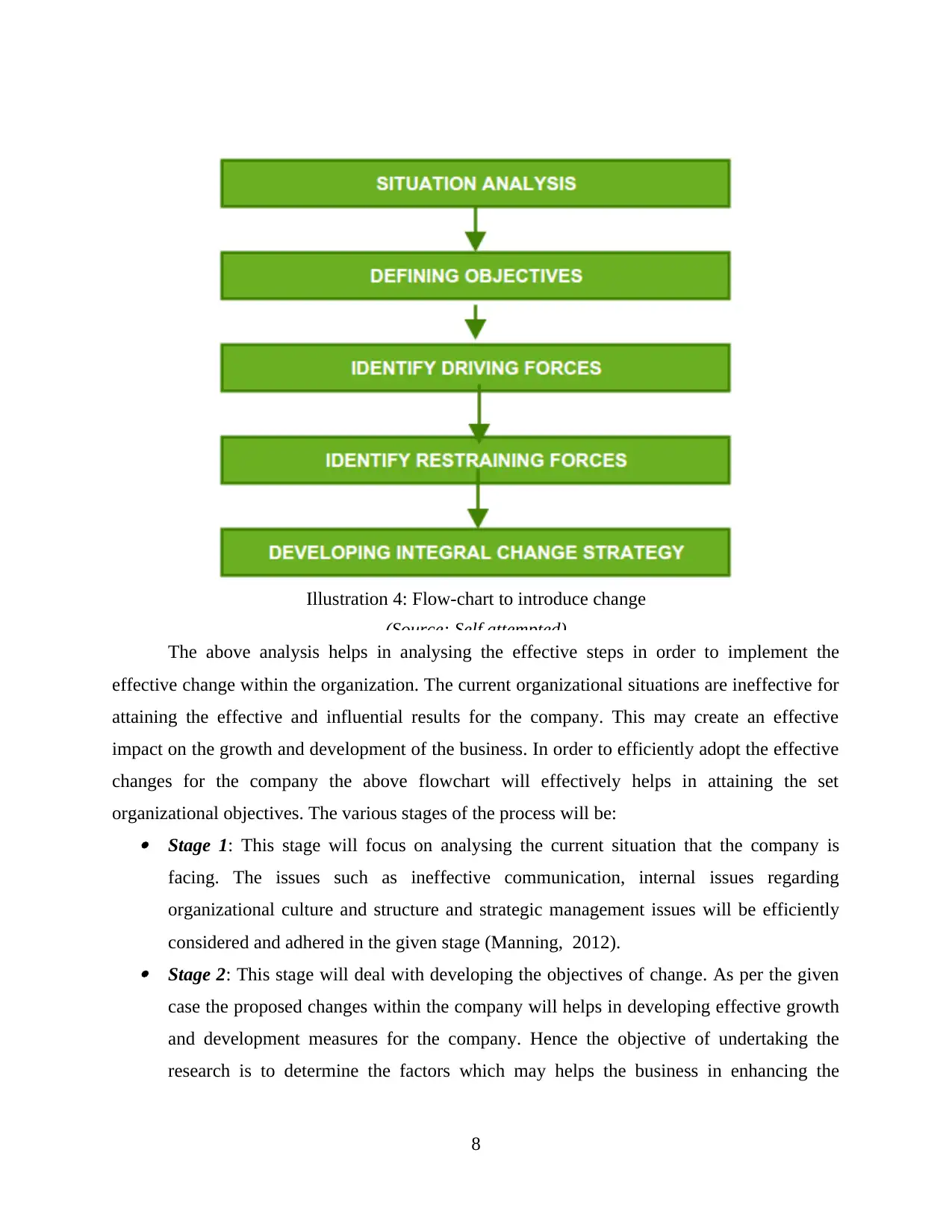
The above analysis helps in analysing the effective steps in order to implement the
effective change within the organization. The current organizational situations are ineffective for
attaining the effective and influential results for the company. This may create an effective
impact on the growth and development of the business. In order to efficiently adopt the effective
changes for the company the above flowchart will effectively helps in attaining the set
organizational objectives. The various stages of the process will be: Stage 1: This stage will focus on analysing the current situation that the company is
facing. The issues such as ineffective communication, internal issues regarding
organizational culture and structure and strategic management issues will be efficiently
considered and adhered in the given stage (Manning, 2012). Stage 2: This stage will deal with developing the objectives of change. As per the given
case the proposed changes within the company will helps in developing effective growth
and development measures for the company. Hence the objective of undertaking the
research is to determine the factors which may helps the business in enhancing the
8
Illustration 4: Flow-chart to introduce change
(Source: Self attempted)
effective change within the organization. The current organizational situations are ineffective for
attaining the effective and influential results for the company. This may create an effective
impact on the growth and development of the business. In order to efficiently adopt the effective
changes for the company the above flowchart will effectively helps in attaining the set
organizational objectives. The various stages of the process will be: Stage 1: This stage will focus on analysing the current situation that the company is
facing. The issues such as ineffective communication, internal issues regarding
organizational culture and structure and strategic management issues will be efficiently
considered and adhered in the given stage (Manning, 2012). Stage 2: This stage will deal with developing the objectives of change. As per the given
case the proposed changes within the company will helps in developing effective growth
and development measures for the company. Hence the objective of undertaking the
research is to determine the factors which may helps the business in enhancing the
8
Illustration 4: Flow-chart to introduce change
(Source: Self attempted)
⊘ This is a preview!⊘
Do you want full access?
Subscribe today to unlock all pages.

Trusted by 1+ million students worldwide
1 out of 18
Related Documents
Your All-in-One AI-Powered Toolkit for Academic Success.
+13062052269
info@desklib.com
Available 24*7 on WhatsApp / Email
![[object Object]](/_next/static/media/star-bottom.7253800d.svg)
Unlock your academic potential
Copyright © 2020–2025 A2Z Services. All Rights Reserved. Developed and managed by ZUCOL.





